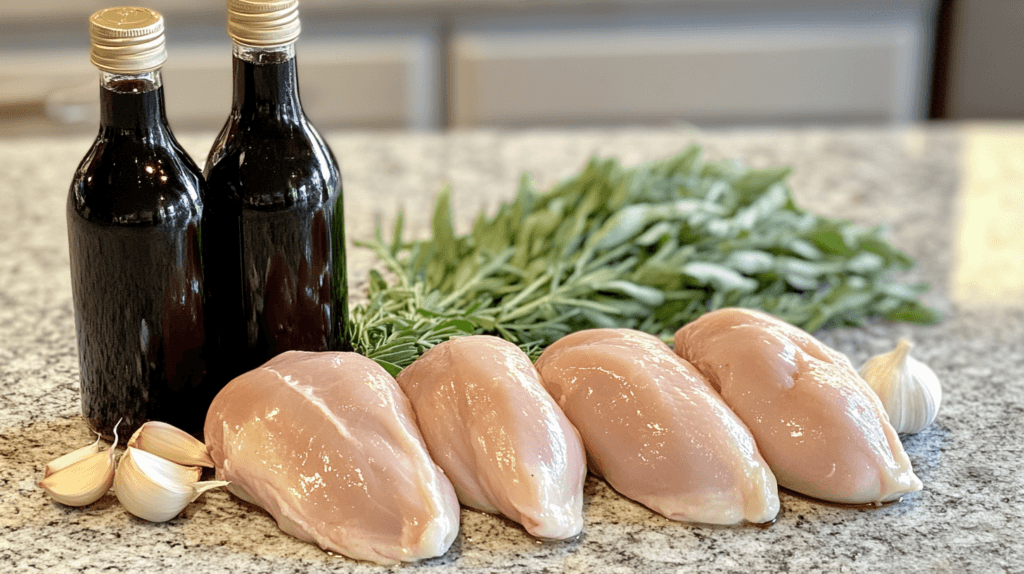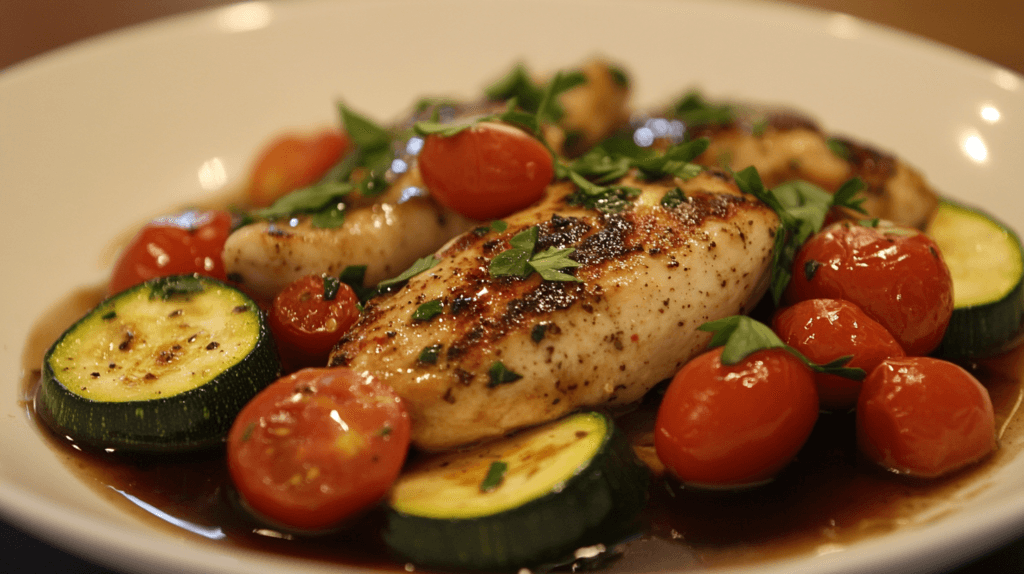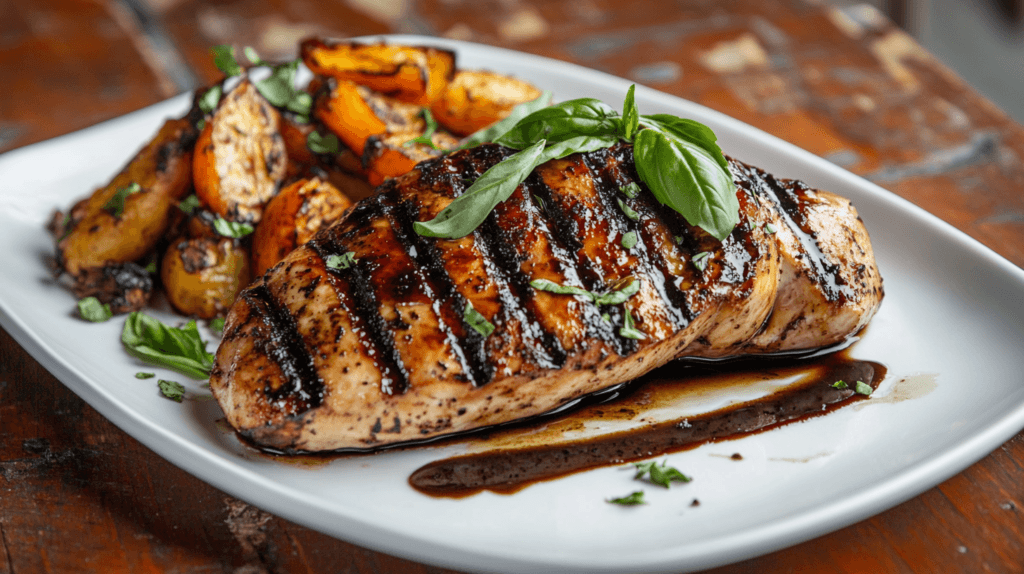Who doesn’t love a simple, flavorful chicken recipe that’s as easy to prepare as it is delicious to eat? Balsamic chicken checks all those boxes and then some! This dish is a perfect blend of tangy sweetness from balsamic vinegar, savory goodness from chicken, and a touch of herbs and spices that make the flavors pop. Whether you’re cooking for a family dinner or looking to impress guests, balsamic chicken is a recipe you’ll want in your repertoire.
What makes balsamic chicken a standout? It’s versatile enough to pair with almost any side dish, and it suits a range of cooking methods, from pan-searing to baking or grilling. Plus, it’s healthy, packed with protein, and can be adapted to fit different dietary preferences. Let’s dive into the nitty-gritty of crafting this amazing dish.
Table of Contents
Ingredients

Core Ingredients for Balsamic Chicken
- Chicken: Boneless, skinless chicken breasts are the most common choice, but thighs work well if you prefer a juicier cut.
- Balsamic Vinegar: High-quality balsamic vinegar is key to achieving the rich, tangy flavor that defines this dish.
- Olive Oil: Extra virgin olive oil adds richness and helps in cooking the chicken evenly.
- Garlic: Fresh minced garlic enhances the overall taste with a punch of aromatic flavor.
- Honey: A touch of honey balances the acidity of balsamic vinegar, creating a harmonious sweetness.
- Dried or Fresh Herbs: Basil, thyme, or oregano work wonderfully to complement the flavors.
- Salt and Pepper: Simple seasoning is all you need to let the balsamic shine.
Choosing the Right Balsamic Vinegar
Not all balsamic vinegars are created equal. For this recipe, look for one that is rich and slightly syrupy. Aged balsamic vinegar is a great choice because it has a deeper flavor profile and natural sweetness.
Optional Ingredients for a Twist
- Mustard: A teaspoon of Dijon mustard adds depth and a slight tanginess.
- Chili Flakes: If you love a spicy kick, sprinkle some chili flakes into your marinade.
- Vegetables: Bell peppers, zucchini, or cherry tomatoes can be cooked alongside the chicken for a complete meal.
Kitchen Tools
Essential Tools You’ll Need
To prepare balsamic chicken with ease, make sure you have the following kitchen tools:
- Mixing Bowls: For combining the marinade ingredients.
- Knife and Cutting Board: To prep the chicken and other ingredients.
- Tongs or Spatula: For flipping the chicken during cooking.
- Non-Stick Skillet or Grill Pan: For searing or grilling the chicken.
- Baking Dish: If you opt for oven-baked balsamic chicken.
- Meat Thermometer: To ensure the chicken is cooked to the perfect temperature.
Optional Tools for Enhanced Cooking Experience
- Marinade Brush: To evenly coat the chicken with the balsamic glaze.
- Cast Iron Pan: Adds a rustic flavor if you’re pan-searing the chicken.
- Zester or Grater: For adding a hint of lemon zest to brighten the dish.
Preparation
Prepping the Chicken
Start with fresh, boneless chicken breasts or thighs when preparing a balsamic chicken recipe. Trim any excess fat or sinew to ensure even cooking. If the breasts are particularly thick, consider pounding them lightly with a meat mallet to an even thickness. This step not only reduces cooking time but also ensures the chicken absorbs the marinade more effectively.
Preparing the Marinade
The marinade is the star of this recipe, infusing the chicken with layers of flavor. Here’s how to make it:
- In a bowl, whisk together the following:
- 1/3 cup balsamic vinegar
- 2 tablespoons olive oil
- 2 tablespoons honey
- 2 minced garlic cloves
- 1 teaspoon dried basil
- 1 teaspoon salt
- 1/2 teaspoon black pepper
- Adjust sweetness and acidity to your taste by adding a little more honey or vinegar if needed.
How Long to Marinate for the Best Flavor
Put the chicken in a resealable plastic bag or a shallow dish. Pour the marinade over it, making sure the chicken is fully coated. Marinate for a minimum of 30 minutes at room temperature or up to 8 hours in the refrigerator. The longer it marinates, the richer the flavor of the chicken.
Cooking Methods
Pan-Seared Balsamic Chicken
- Heat a non-stick skillet over medium-high heat and add a drizzle of olive oil.
- Remove the chicken from the marinade (save the leftover marinade) and place it in the skillet.
- Sear each side for 4-5 minutes until golden brown.
- Reduce heat, pour the remaining marinade into the skillet, and let the chicken simmer until cooked through (internal temperature should reach 165°F/75°C).
Oven-Baked Balsamic Chicken
- Preheat your oven to 375°F (190°C).
- Arrange the marinated chicken in a baking dish.
- Pour any leftover marinade over the chicken.
- Bake for 20–25 minutes or until the chicken’s internal temperature reaches 165°F (75°C).
Grilled Balsamic Chicken
- Heat the grill to medium-high and grease the grates lightly.
- Place the chicken on the grill, cooking for 5-6 minutes on each side.
- Brush with extra marinade during cooking for enhanced flavor.
Step-by-Step Cooking Guide
Cooking Balsamic Chicken to Perfection
- Heat Your Cooking Surface: If using a skillet or grill pan, heat it over medium-high heat and add a drizzle of olive oil to prevent sticking. For baking, preheat the oven to 375°F (190°C).
- Remove Chicken from Marinade: Take the chicken out of the marinade, letting excess drip off, but do not discard the marinade.
- Sear (Optional Step): For baked or grilled chicken, quickly sear it on both sides in a hot skillet for 2-3 minutes to lock in the juices and create a beautiful golden crust.
- Cook Thoroughly:
- Pan-Seared: Lower the heat to medium and continue cooking for 5-6 minutes per side until the internal temperature reaches 165°F (75°C). Add the reserved marinade to the pan during the last few minutes for a rich glaze.
- Oven-Baked: Bake for 20-25 minutes, basting with reserved marinade halfway through.
- Grilled: Cook over medium heat for 5–7 minutes on each side, occasionally brushing with marinade.
- Let Rest: Remove the chicken from heat and let it rest for 5 minutes before serving. This allows the juices to redistribute, keeping the meat juicy and tender.
Checking for Doneness
Always use a meat thermometer to ensure your chicken is cooked thoroughly. The USDA advises an internal temperature of 165°F (75°C) for poultry. If you don’t have a thermometer, slice into the thickest part of the chicken—it should be opaque and the juices should run clear.
Avoiding Common Mistakes
- Overcooking: This is the most common mistake with chicken. Use a timer and thermometer to avoid drying it out.
- Undercooking: Be sure to check the internal temperature for food safety.
- Burning the Marinade: Balsamic vinegar has natural sugars that can burn easily. If cooking on high heat, add the marinade later in the process or use indirect heat.
Serving Suggestions
Perfect Side Dishes for Balsamic Chicken
- Vegetables: Roasted asparagus, sautéed spinach, or garlic green beans add freshness and color to the plate.
- Carbs: Serve with creamy mashed potatoes, wild rice, or buttered noodles to soak up the delicious balsamic glaze.
- Salad: Pair it with a crisp Caesar salad or a fresh arugula and tomato salad.
Wine Pairings
Balsamic chicken pairs beautifully with light-to-medium bodied wines such as:
- White Wine: Sauvignon Blanc or Pinot Grigio.
- Red Wine: Pinot Noir or Merlot.
Garnishing for Presentation
A sprinkle of chopped fresh parsley or basil adds a pop of color. Drizzle extra balsamic glaze on top for a restaurant-quality look. You can also add a wedge of lemon for an optional zesty finish.
Variations of Balsamic Chicken recipe

Balsamic Chicken with Vegetables
Add sliced zucchini, cherry tomatoes, or bell peppers to the dish. Cook them alongside the chicken in the skillet or baking dish for a complete one-pan meal.
Creamy Balsamic Chicken recipe
For a creamy variation, stir in a splash of heavy cream or coconut milk to the sauce once the chicken is fully cooked. This creates a rich, velvety texture that’s perfect for colder months.
Spicy Balsamic Chicken recipes
Kick up the heat by adding a teaspoon of chili flakes or cayenne pepper to the marinade. This version is great for those who love bold, fiery flavors.
Tips for the Best Flavor
Balancing Sweetness and Acidity
The balance between the tangy acidity of balsamic vinegar and the sweetness of honey is key to this recipe. Here are some tips to achieve perfection:
- If the dish tastes too tangy, add a little more honey or brown sugar to the marinade.
- If it’s too sweet, a splash of fresh lemon juice or an extra drizzle of balsamic vinegar can bring back balance.
How to Avoid Overpowering the Dish with Vinegar
Balsamic vinegar is potent, so moderation is important. Stick to the recipe proportions, and if you’re trying it for the first time, err on the side of less vinegar. You can always add more later during cooking.
Using Fresh Herbs for Added Depth
Fresh herbs like rosemary, thyme, or basil elevate the flavor profile of balsamic chicken. Add them as a garnish or toss them into the marinade for a more aromatic dish. You can also mix dried herbs into the marinade, but fresh herbs offer a more vibrant taste.
Storage and Reheating
Properly Storing Leftovers
- Refrigeration: Place leftover balsamic chicken in an airtight container and store it in the refrigerator for up to 3-4 days.
- Freezing: If you want to freeze it, wrap the chicken tightly in plastic wrap and place it in a freezer-safe bag or container. It will keep well for up to 2 months.
Reheating Without Losing Flavor or Texture
- Stovetop: Warm the chicken in a skillet over low heat, adding a splash of water or broth to keep it moist.
- Microwave: Heat in short intervals (30 seconds at a time), checking frequently to avoid drying out.
- Oven: Reheat at 350°F (175°C) for about 10 minutes, covering with foil to prevent moisture loss.
Can You Freeze Balsamic Chicken?
Yes! Cooked balsamic chicken freezes beautifully, making it a convenient option for meal prep when following a balsamic chicken recipe. Just ensure it’s cooled completely before freezing, and thaw it overnight in the refrigerator before reheating.
Health Benefits
Nutritional Benefits of Balsamic Vinegar
Balsamic vinegar isn’t just tasty; it’s also packed with health perks:
- Rich in Antioxidants: Protects against cellular damage.
- Low in Calories: Enhances flavor without adding extra calories.
- Supports Heart Health: Its acetic acid content can help regulate cholesterol levels.
Health Advantages of Lean Chicken Breast
- High in Protein: Supports muscle growth and repair.
- Low in Fat: Chicken breast is an excellent option for those watching their fat intake.
- Rich in Vitamins: Contains essential nutrients like Vitamin B6, which supports brain health.
FAQ
What is the Best Type of Chicken for This Recipe?
Boneless, skinless chicken breasts are the most popular choice, but thighs are a great alternative for a juicier texture and richer flavor.
Can I Use Other Types of Vinegar Instead of Balsamic?
While balsamic vinegar is the star, red wine vinegar or apple cider vinegar can be used in a pinch. However, you’ll need to adjust the sweetness with extra honey or sugar. Curious about tangy complements? Learn what to serve with rotisserie chicken for more pairing ideas.
How Long Should I Marinate the Chicken?
For the best flavor, marinate the chicken for at least 30 minutes, but ideally, allow it to marinate for 4-8 hours in the refrigerator. Wondering about meal prep and storage? Discover how long rotisserie chicken stays good in the fridge.
What Can I Do If I Don’t Have Fresh Herbs?
Dried herbs work just fine! Use about half the amount of dried herbs as you would fresh ones since they’re more concentrated.
Is Balsamic Chicken Keto-Friendly?
Yes! By skipping the honey or using a keto-friendly sweetener, balsamic chicken becomes a great low-carb, keto-friendly option.
How Do I Know If the Chicken is Fully Cooked?
Use a meat thermometer to confirm the internal temperature reaches 165°F (75°C). Alternatively, cut into the thickest part; it should be opaque with clear juices. For grilling tips, learn what is good to cook on a Traeger.
Conclusion
Balsamic chicken is the perfect blend of simplicity and elegance, making it a go-to recipe for any occasion. From its tangy glaze to its tender, juicy meat, it’s a dish that never fails to impress. Whether you’re preparing it for a weeknight dinner or a special gathering, the versatility of balsamic chicken allows you to customize it to your liking. Don’t be afraid to experiment with side dishes, marinades, and cooking methods to make it your own.
If you’re searching for more inspiration, take a look at rockfish recipes or molcajete recipes. Ready to start cooking? Your taste buds will thank you! 😊

